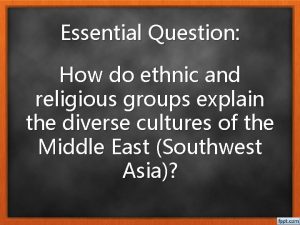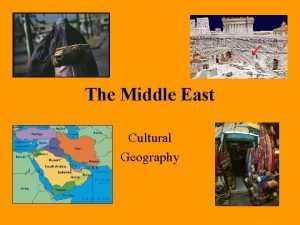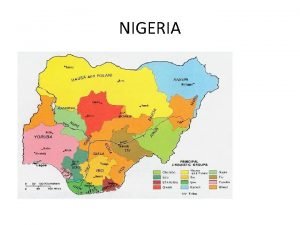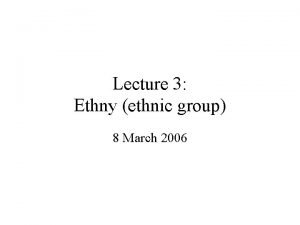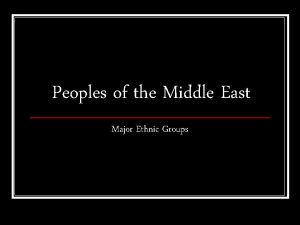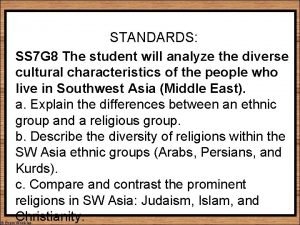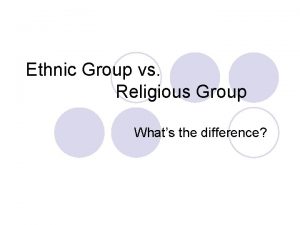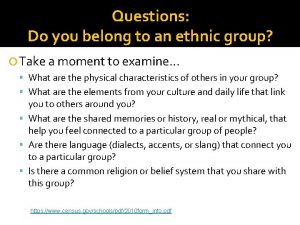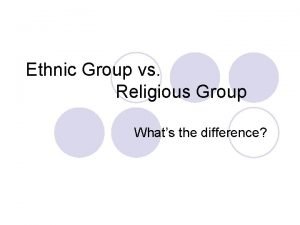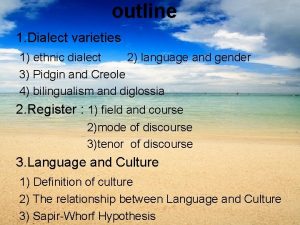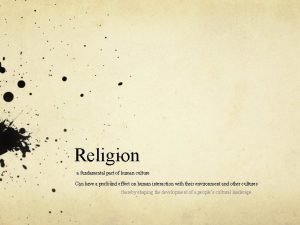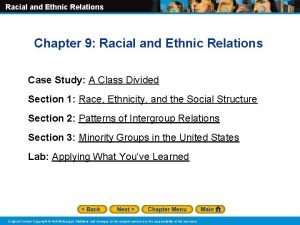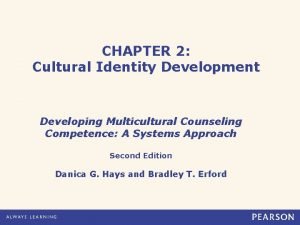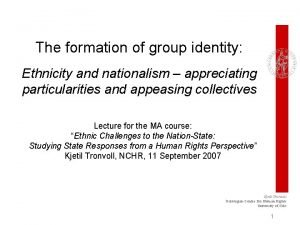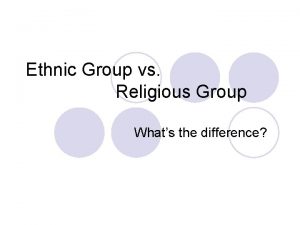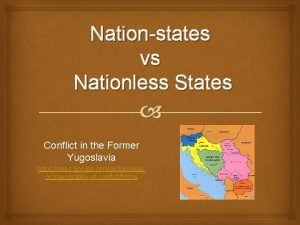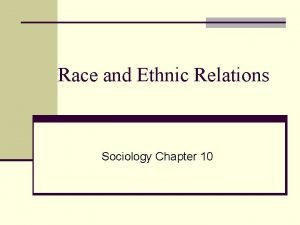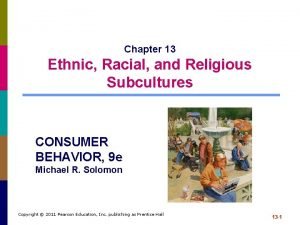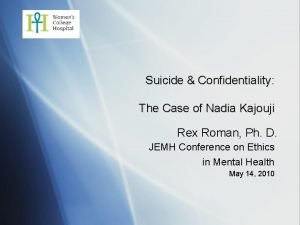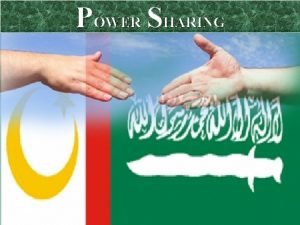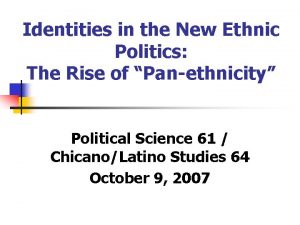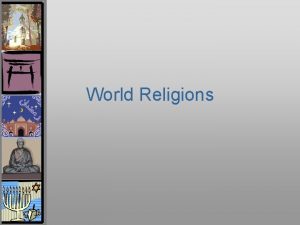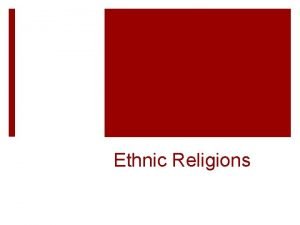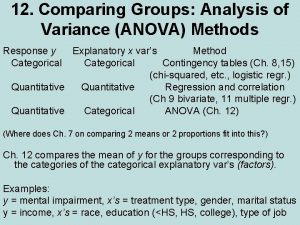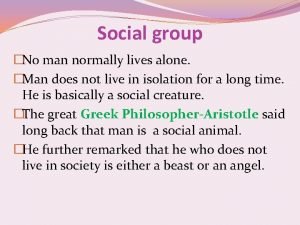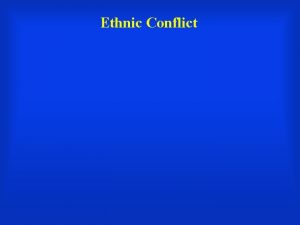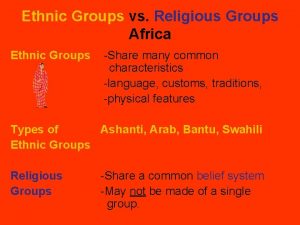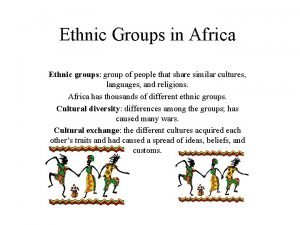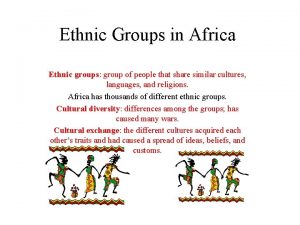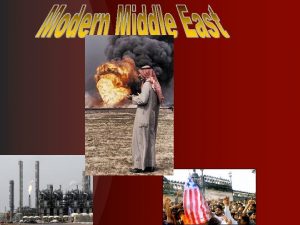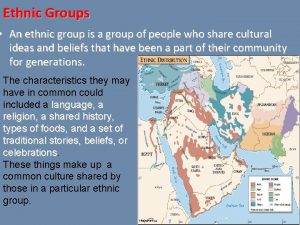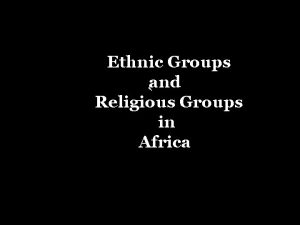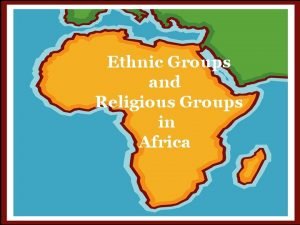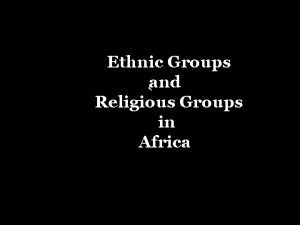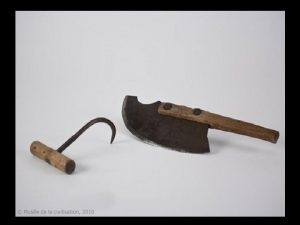Ethnic Groups ethnic group is a group of


















































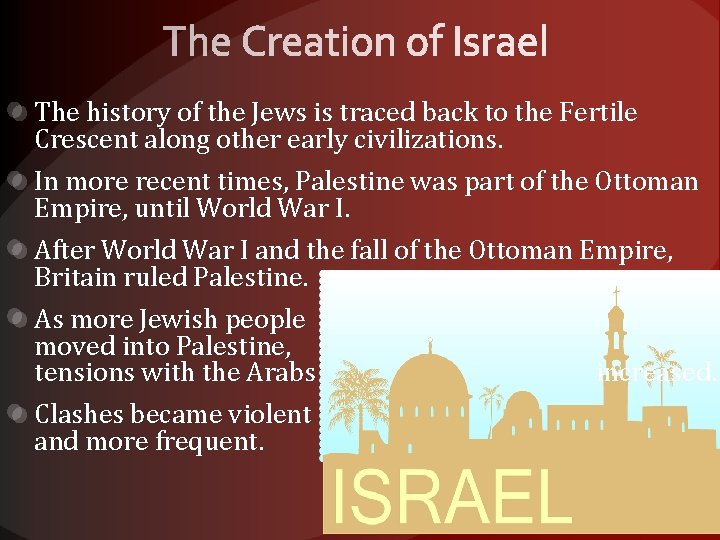
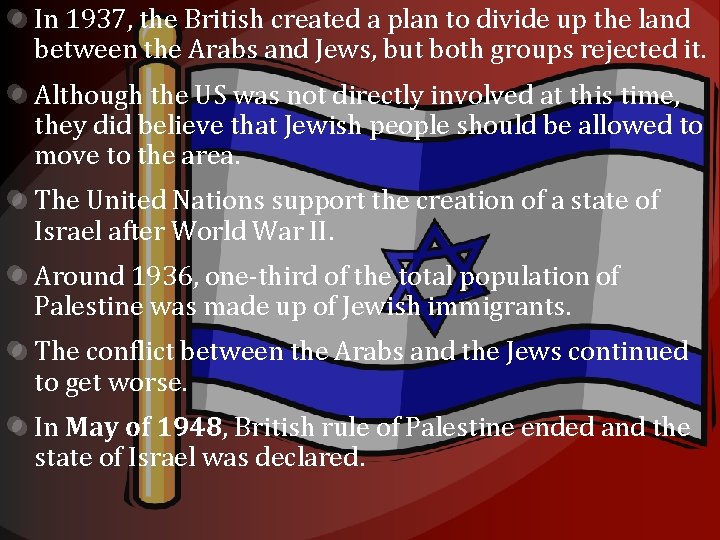
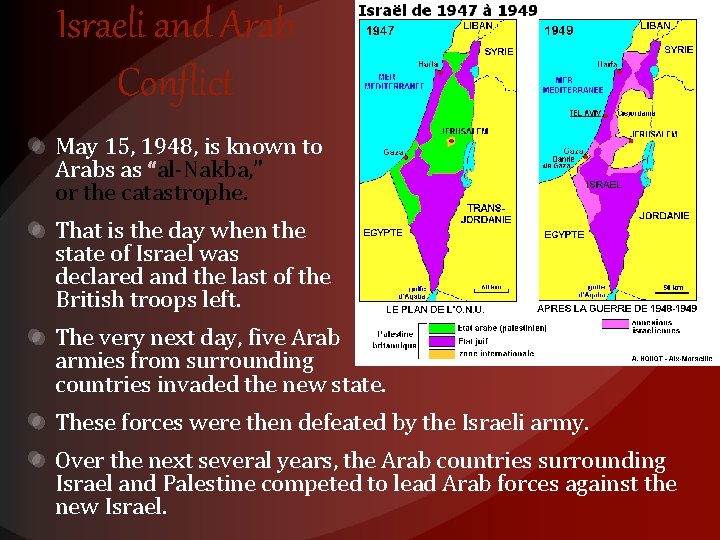

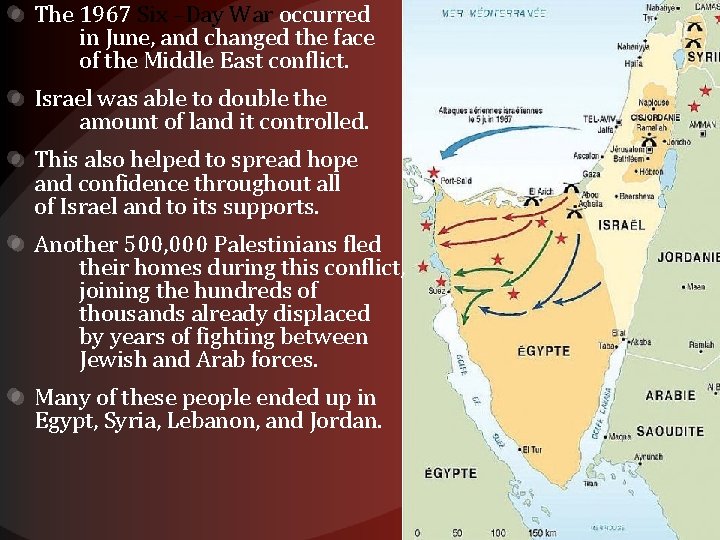
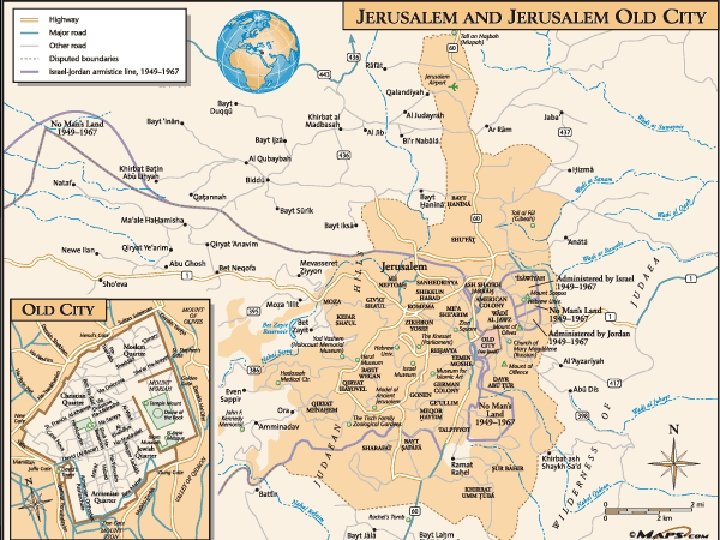
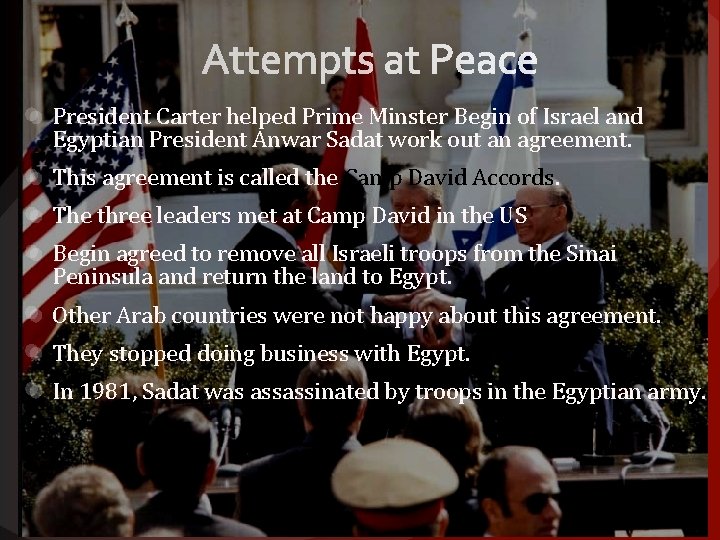

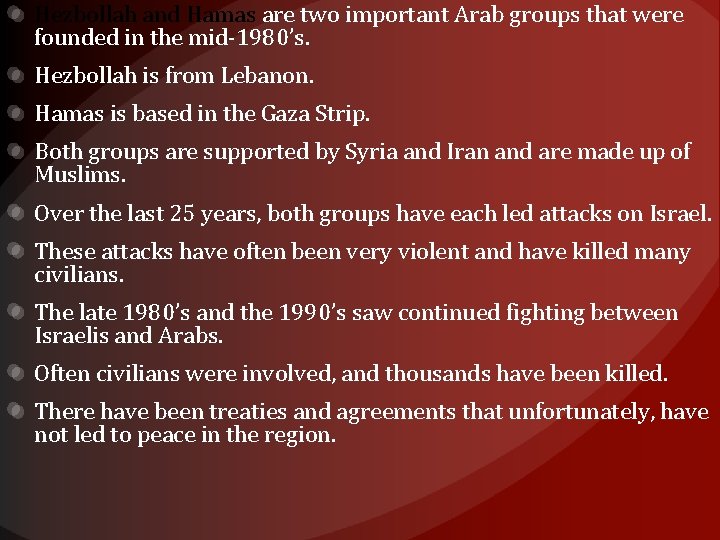
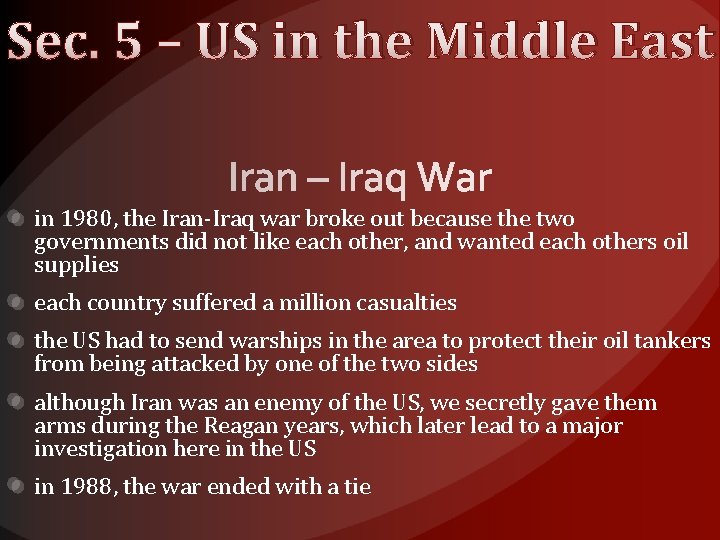
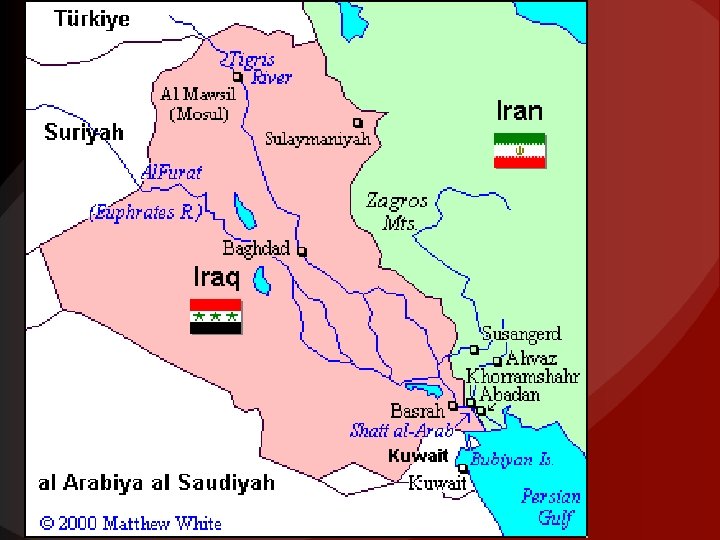
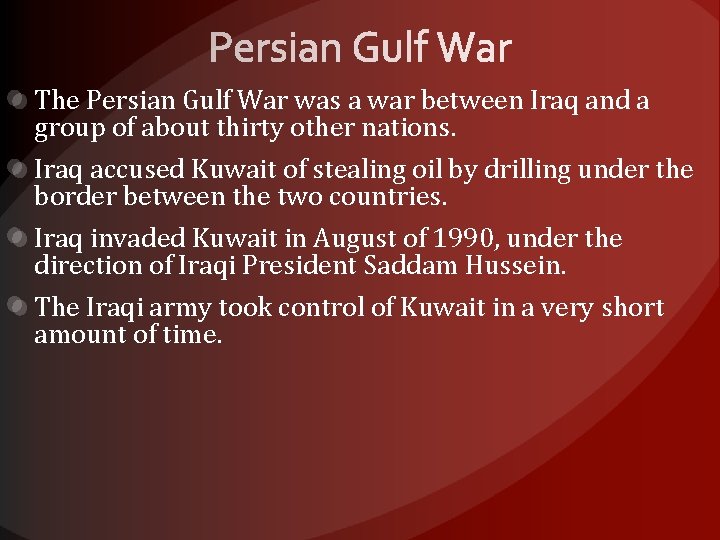




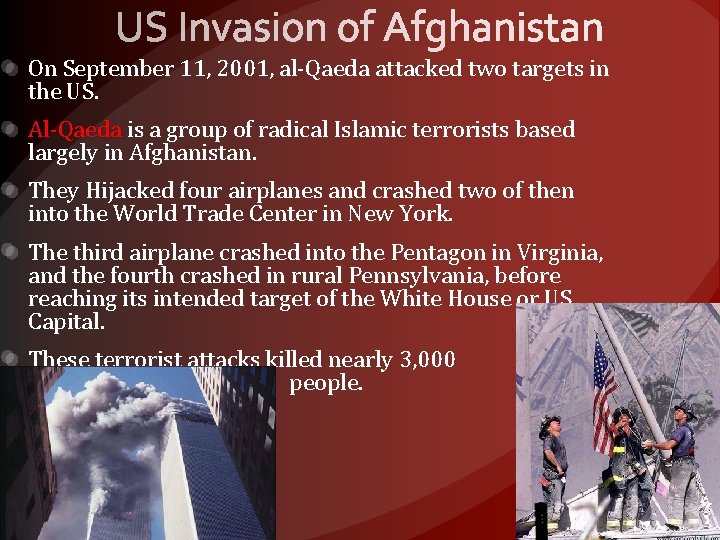
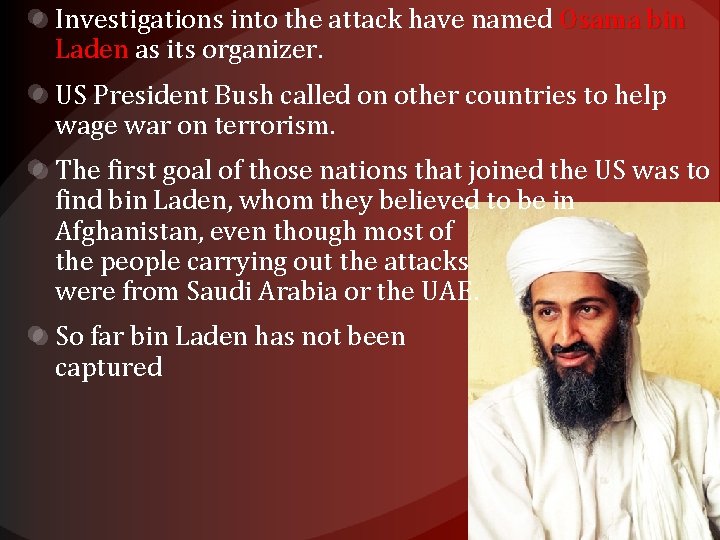
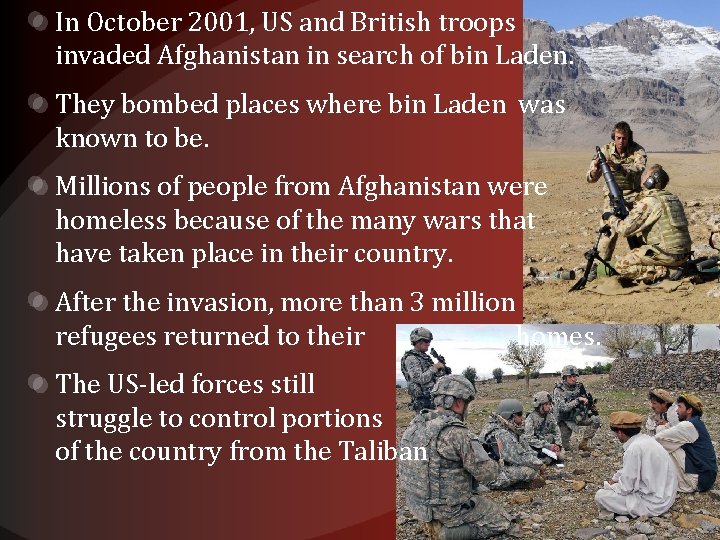

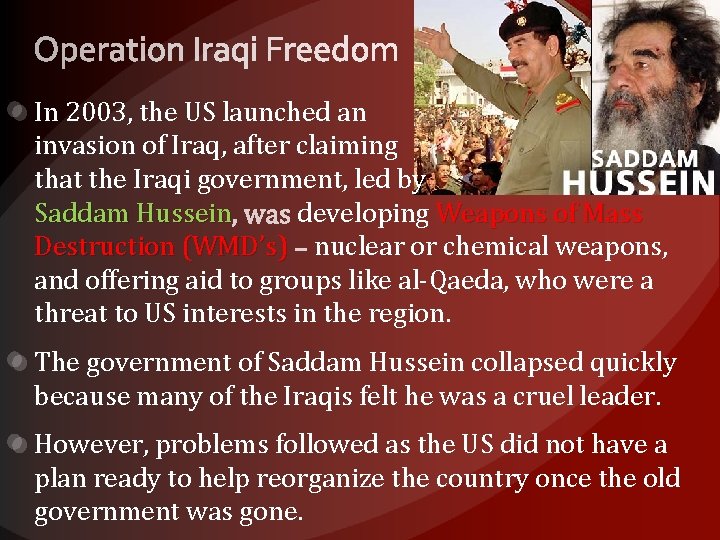

- Slides: 72


Ethnic Groups ethnic group is a group of people who share cultural ideas and beliefs that have been a part of their community for generations. The characteristics they may have in common could included a language, a religion, a shared history, types of foods, and a set of traditional stories, beliefs, or celebrations. These things make up a common those in a culture shared by particular ethnic group.


Religion religious group shares belief system in a god or gods, with a specific set of ritual and literature. People from different ethnic groups may share the same religion; through they may be from very different cultures. Religion has been important to the history of the Middle East. Christianity, Islam, and Judaism were started in this region. People who follow Judaism are called Jews. Followers of Christianity are called Christians. Followers of Islam are called Muslims. a

Ethnic Group Religious Group

Arabs Southwest Asia is home to many different ethnic groups who share similar religions. The Arabs of Southwest Asia believe themselves to be descendants of Abraham in the Bible, through his son Ishmael. They make up the majority of those who live throughout the region known as the Middle East, though there are many differences among them. Most Arabs practice the religion of Islam and call themselves Muslims. Most Arabs, whether they are Muslim or Christian, speak the Arabic language.

Persians are those who live in the modern country of Iran. The Persian people are descended from a different group than those who are Arabs and Jews. Their ancestors were Indo-Europeans from Central Europe and Southern Russia. The country of Persia became known as Iran after World War I. Persians, or Iranians, speak Farsi, a language that uses the Arabic alphabet but is actually a different language. They practice Islam, but most belong to the Shia group of Muslims. About 15 percent of Muslims in the world are Shia. The other 85 percent are Sunni Muslims.

The Kurds are an ethnic group the lives in several different countries in the Middle East. Most Kurds are found in the mountainous areas where Syria, Turkey, Iran, and Iraq come together. The Kurds see themselves as a distinct ethnic group from others in the area. They speak their own language, known as Kurdish, and have a separate history, literature, music, and set of traditions. Many Kurds hope to have a nation of their own some day, a hope that has caused conflict with the countries in which Kurdish people live. Most Kurds are Sunni Muslim, though there is a small minority who are Shia Muslims.

The Middle East has a common culture which includes the Arabic language and the Islamic religion. For centuries, kingdoms and empires have battled for control of the region. Three continents (Europe, Asia, & Africa) meet in the Middle East. Important trade routes have long passed through the region. For many years, whoever controlled the Middle East held great influence over much of the world’s economy.

Section 2 – Religions of the Middle East üThe three major religions that originated in Southwest Asia are Judaism, Christianity, and Islam. üAll are based on monotheism, a belief in one god. üEach religion has a sacred text, or book, which is at the core of its faith. üEach book is a collection of writings compiled time. üNone was written by the central figure of the faith. üAll three faiths trace their ancestry back thousands of years to the prophet Abraham

Judaism is the oldest of the three religions. It began as a set of beliefs and laws practiced by ancient Hebrew people in Southwest Asia. Its book is the Hebrew Bible – aka The Torah Jews believe that one day a human leader will come as a messenger of God and bring about a golden age. They call this leader the messiah In Greek versions of the Bible, messiah is written as christos the anointed one.

The Bible names Abraham as the father of the Jews. There is no other evidence of his life. Scholars place Abraham living sometime between 2000 and 1500 BCE (BC) The Bible states that Abraham was born in Ur in presentday Iraq. He later moved to Canaan in present-day Israel. Jews believe Canaan is the Promised Land, which God promised to Abraham and his descendants.

they were the first religion to be monotheistic and it is one of the worlds oldest religion their holy book is the first five books of the Bible, which they call the Torah - this is what Moses delivered to the Israelites from God The rest of the Jewish bible – the Christian Old Testament – are the writings of prophets Prophet – a person thought to be inspired by God More writings on Jewish law, history, and folklore are collected in the T a l m u d

It was said that Abraham’s grandson Jacob had 12 sons. The twelve tribes of Israel began with Jacob's sons. Jacob was later called Israel, and his descendants are called Israelites Sabbath The seventh day of the week, Saturday, observed by Jews as a day of worship and rest Kosher fit to be eaten, according to Jewish dietary laws Passover Jewish festival marking the flight or Exodus of the Israelites from Egypt Rabbi teacher of Jewish law; spiritual head of a congregation

According to the Bible, the First Temple for Jewish worship was built around 900 -1000 BCE and destroyed by Babylonians in 586 BCE. The Jews were then sent out of Canaan, but returned after 50 years in exile. A Diaspora occurs when a group of people leave their homeland move to many different locations separately. All of the world’s Jewish today that do not day Israel are part Diaspora communities live in presentof the Jewish

A new temple was finished 70 years later on site of the First Temple, but was badly plundered by invading Romans 54 BCE. the about King Herod a Jew, ruled Judea for the Romans. The second temple was in 20 BCE. rebuilt When the Romans attacked Jerusalem again in 70 CE(AD), they destroyed Herod’s temple. Today, the single remaining temple wall the Western Wall is a place of prayer for Jewish pilgrims. Jews moved away from the land again, until the modern state of Israel was formed in the late 1940 s.

In 30 CE, a Jew named Jesus began preaching new ideas about Judaism in Roman-controlled Judea. The later title of Jesus Christ given to Jesus is a reference to the belief by his followers that he is the Jewish messiah.

According to the Christian New Testament, Jesus preached only to his fellow Jews. His idea was that the old laws of Judaism should be replaced by a simpler system based on love of one's fellow human beings. He began to grow popular. Jewish leaders did not want Jesus to threaten their power and asked the Romans to arrest him. The Romans found him guilty of speaking against Jewish laws and sentenced him to death by crucifixion or being hung on a cross. He died in 33 CE, after preaching for only three years.

ØHammurabi was a king of Babylon who set up the first written law called Hammurabi’s code ØIt was a collection of 282 laws with the most famous being and “eye or an eye” ØLaw was equal depending on your social class

Jesus had 12 close followers, or disciples Interestingly, a man who had never met Jesus became the person to spread his message around the world. Paul of Tarsus had a vision of Jesus after the crucifixion that told him to teach Jesus' ideas to non-Jews. Paul traveled to build churches throughout the ancient world in Ephesus, Corinth, Rome, and other cities. The New Testament records Paul’s journeys through a series of letters, or epistles, that he wrote.

ØThe Fertile Crescent is a crescent-shaped, or curved, area of fertile land along the Tigris and Euphrates River ØAs the population of the Fertile Crescent increased, wars began to break out among the growing number of city-states, mostly over land water ØPhoenician’s spread their culture and their developed alphabet all over the trade and conquest since sea voyagers newly area through they were excellent



By 100 CE, the growth of Christianity was left to a new generation of people who had never known Jesus and who did not know Jewish laws. Roman authorities fought the growth of Christianity. Christians were often arrested and killed. A number of Roman emperors launched bloody campaigns against the new faith. Christians were thrown into public arenas to be torn apart by wild animals. Nero had some lit on fire to serve as human torches. Most Christians practiced their religion in hiding, but their numbers continued to grow and the religion spread.

By the early 4 th century, Christianity may have reached members of the Roman emperor’s family. The Roman Emperor Constantine was not a Christian, but he had his soldiers fight an important battle in 313 with a Christian symbol on their shields. His army won the battle.

In the nearly 300 years since his death, many different ideas had developed about how to follow Jesus. In 325 CE, Constantine called a meeting for all the Christen leaders to meet in Nicea. About 300 men attended the meeting to discuss how Christianity should be practiced. The council produced the Nicene Creed the first attempt at a uniform statement of Christian doctrine found in the current New Testament. When the Christian leaders left this meeting, a new type of Christian church had been formed. This new church was said to be Catholic which means universal.

Three main divisions of Christianity: Roman Catholic (headed by a pope in Rome), Eastern Orthodox, and Protestant a Christian that split from the Roman Catholic church in the 16 th century Gospels The first four books of the New Testament containing the life and teachings of Jesus Christ Easter Holiday commemorating the resurrection of Jesus Christ Resurrection The rising of Jesus Christ from the dead on the third day after his crucifixion Eucharist blessed bread and wine shared in Christian worship; also called Holy Communion Baptism ceremony of initiation into the Christian church, usually with water

The Prophet Muhammad was an Arab born in 570 CE, in Mecca which is in present-day Saudi Arabia. He was a merchant known as “al-Amin, ” the trustworthy one. According to Islamic tradition, in 610 CE, while he was praying in a cave, he had a vision of the angle Gabriel a figure in the Hebrew Bible. The angle gave him messages from God, called Allah in Arabic.

Muhammad taught that Abraham, Moses, and Jesus were each prophets, but that Jews and Christians had misunderstood their teachings. Many of the poor who heard Muhammad’s message accepted it because he called for social justice and equality. A great number of powerful leaders and rich merchants, however, rejected Muhammad's message. They saw him has a threat to their economic security.

Muhammad spread the messages he received from Allah. He was forced to flee Mecca for Medina in 622 CE. This flight is known as the Hijrah Islamic calendar begins at this date. By the time he died in 632 CE, Islamic control of central Arabia was well underway.

Before 700 CE, Muhammad’s followers were fighting over his successor. The fight split Muslims into the Shi’a and the Sunni. The Shi’a comprise 10% - 15% of Islamic followers today and Sunni comprise close to 90%. Sunni Orthodox Muslim who accepts the traditional teachings of the Koran and the authority of the descendants of Caliph Ali. They believe that the Caliph (leader of Islam) does not have to be a blood relative of Muhammad. Shi’a (Shiite) – A Muslim rejects the authority of the religious leaders who succeeded Muhammad’s -in-law Ali & the be a who son Caliph must blood relative.

Within a century, Islam spread throughout the Middle East and North Africa. Muslims even conquered parts of Spain. Their military campaigns were inspired by a desire to spread Islam, and for some, a desire for wealth and power. Due to divisions in Christianity, many former Christians in North Africa actually welcomed the new religion.

Islam has other rites, including what Muslims are allowed to eat and drink (They don’t eat pork or drink alcohol) Also, the Qur'an, their scared book, explains a concept called jihad. Jihad requires believers to meet the enemies of Islam in combat. Enemies can be attacked by the heart, the tongue, the hand, or the sword. Muslims pray at a Mosque Minaret a high slender tower attached to a mosque They write in calligraphy Calligraphy beautiful or elegant handwriting


Section 3 – History the Christians in Europe wanted to take back the Holy Land from the Muslims, so they sent armies there to do the job Pope Urban II started the Crusades in 1095, he sent an army to take the land of Jesus, which is modern day Israel the first crusade was successful, but the Christians slaughtered many Muslims and Jews at the time, the Islamic civilization was more advanced than Europe’s, so soon the Muslim’s, under general Saladin, Saladin eventually drove the Christians out Saladin called for a jihad or holy war


The Ottoman Empire began in 1299, in Turkey, which is located in southwestern Asia. It lasted longer than any Muslim empire in history. The empire grew had later included parts of Asia, the Middle East, Africa, and Europe. The Turks had been ruled by the Byzantine Empire prior to 1299. By the 13 th century, the Byzantine Empire was in decline.


Osman was a Turkish warrior and a Muslim. He had many followers, called Ottomans. Through successful military campaigns and the promise of booty (wealth taken after battle). Osman gained soldiers and his domain grew. In 1299, Osman conquered the last of the Byzantine villages and the Ottoman Empire began. Osman was the first Ottoman sultan is the ruler of a Muslim state.

The Ottoman Empire controlled many trade routes. It had access to the Persian Gulf, the Black Sea, and the Mediterranean Sea. Europe and Asia were linked by Ottoman trade routes. This connection helped join these distant cultures.

Most countries of Western Europe looked at the Ottoman Empire as a threat. European Christians feared the spread of Islam. Many European traders did not want to trade with the Ottomans because of this fear. All trade routes to the east were under Ottoman control. Western Europeans began to search for other ways to reach Asia This search led to the age of exploration, during which the New World was and explored. discovered

By the 20 th century, the Ottoman Empire was weak. It sided with the Central Powers in World War I, which fought against the Allied powers of England, France, Russia, and the United States. The Ottoman troops won only one key battle in World War I, the battle of Gallipoli

Middle East 1880 Middle East 1920

The British took control of Jerusalem and Baghdad from the Ottomans. Arabia then rose up against Ottoman rule. By 1918, the Ottoman Empire had ended. In 1920, after the end of World War I, the Treaty of Sevres split the land of the Ottoman Empire among Allied, or Western, powers. France was grated mandates over Syria and Lebanon. The United Kingdom was grated Palestine and Iraq. The modern Turkish republic was declared on October 29, 1923. Today, Turkey is the largest Muslim nation in Europe.

End of Section 1

ed g Zionism -Semitism anti Holocaust

Zionism is a Jewish movement that began in Europe in the late 19 th century. Its goal was to establish a Jewish homeland in Palestine. Theodor Herzl started the movement and also led the first Zionist Congress in 1897. After World War I, the movement popularity. In 1917, Britain issued the Balfour Declaration which stated that Britain work toward the establishment national home for the Jewish people Palestine. grew in would of a in

Anti-Semitism is hostility toward or prejudice against Jews or Judaism. In the late 19 th and early 20 th centuries, anti-Semitism began to spread throughout Europe. Events in Russia, Austria, and France fueled European anti-Semitism. In Russia, anti-Jewish mob attacks, called pogroms began in 1881 and then spread to Central and Eastern Europe. Russians blamed Jews for the assassination of the tsar, the leader of Russia.

The events that led to the Holocaust began in 1933. From the time Adolf Hitler became the chancellor of Germany, the treatment of Jews in Germany, and eventually most of continental Europe, grew worse. The policies of Hitler’s Nazi Party slowly eroded the rights of Jews. The government declared that Jews were no longer German citizens and removed them from their jobs, businesses, schools, and homes.

As Germany took over other European countries, including Poland in 1939, Czechoslovakia, the Netherlands, France, much of Russia, and Austria, Jews in those locations were treated similarly or worse. By the end of the war, Hitler’s final solution to rid the earth of Jews resulted in the murder of six million Jews and the deaths of millions of other Europeans. Often the Jews that could flee moved to Palestine time. The Holocaust ended with Germany’s defeat in World War II in 1945. Europe during this

The history of the Jews is traced back to the Fertile Crescent along other early civilizations. In more recent times, Palestine was part of the Ottoman Empire, until World War I. After World War I and the fall of the Ottoman Empire, Britain ruled Palestine. As more Jewish people moved into Palestine, tensions with the Arabs increased. Clashes became violent and more frequent.

In 1937, the British created a plan to divide up the land between the Arabs and Jews, but both groups rejected it. Although the US was not directly involved at this time, they did believe that Jewish people should be allowed to move to the area. The United Nations support the creation of a state of Israel after World War II. Around 1936, one-third of the total population of Palestine was made up of Jewish immigrants. The conflict between the Arabs and the Jews continued to get worse. In May of 1948, British rule of Palestine ended and the state of Israel was declared.

Israeli and Arab Conflict May 15, 1948, is known to Arabs as al-Nakba, ” or the catastrophe. That is the day when the state of Israel was declared and the last of the British troops left. The very next day, five Arab armies from surrounding countries invaded the new state. These forces were then defeated by the Israeli army. Over the next several years, the Arab countries surrounding Israel and Palestine competed to lead Arab forces against the new Israel.


The 1967 Six –Day War occurred in June, and changed the face of the Middle East conflict. Israel was able to double the amount of land it controlled. This also helped to spread hope and confidence throughout all of Israel and to its supports. Another 500, 000 Palestinians fled their homes during this conflict, joining the hundreds of thousands already displaced by years of fighting between Jewish and Arab forces. Many of these people ended up in Egypt, Syria, Lebanon, and Jordan.


President Carter helped Prime Minster Begin of Israel and Egyptian President Anwar Sadat work out an agreement. This agreement is called the Camp David Accords. The three leaders met at Camp David in the US Begin agreed to remove all Israeli troops from the Sinai Peninsula and return the land to Egypt. Other Arab countries were not happy about this agreement. They stopped doing business with Egypt. In 1981, Sadat was assassinated by troops in the Egyptian army.


Hezbollah and Hamas are two important Arab groups that were founded in the mid-1980’s. Hezbollah is from Lebanon. Hamas is based in the Gaza Strip. Both groups are supported by Syria and Iran and are made up of Muslims. Over the last 25 years, both groups have each led attacks on Israel. These attacks have often been very violent and have killed many civilians. The late 1980’s and the 1990’s saw continued fighting between Israelis and Arabs. Often civilians were involved, and thousands have been killed. There have been treaties and agreements that unfortunately, have not led to peace in the region.

Sec. 5 – US in the Middle East in 1980, the Iran-Iraq war broke out because the two governments did not like each other, and wanted each others oil supplies each country suffered a million casualties the US had to send warships in the area to protect their oil tankers from being attacked by one of the two sides although Iran was an enemy of the US, we secretly gave them arms during the Reagan years, which later lead to a major investigation here in the US in 1988, the war ended with a tie


The Persian Gulf War was a war between Iraq and a group of about thirty other nations. Iraq accused Kuwait of stealing oil by drilling under the border between the two countries. Iraq invaded Kuwait in August of 1990, under the direction of Iraqi President Saddam Hussein. The Iraqi army took control of Kuwait in a very short amount of time.

The UN responded to the Iraqi invasion by demanding that Iraq withdraw its troops from Kuwait. The UN used the Iraqi to try to convince withdraw. economy the country to They did this by cutting off trade to the country. Iraq did not withdraw. The US and other countries began sending troops to Saudi Arabia over the next few months. The UN set a date for Iraq to leave Kuwait. The Iraqis remained in Kuwait after the date. The US and other nations attacked the Iraqi forces in January of 1991. The Iraqi army was defeated in less than two months.




On September 11, 2001, al-Qaeda attacked two targets in the US. Al-Qaeda is a group of radical Islamic terrorists based largely in Afghanistan. They Hijacked four airplanes and crashed two of then into the World Trade Center in New York. The third airplane crashed into the Pentagon in Virginia, and the fourth crashed in rural Pennsylvania, before reaching its intended target of the White House or US Capital. These terrorist attacks killed nearly 3, 000 people.

Investigations into the attack have named Osama bin Laden as its organizer. US President Bush called on other countries to help wage war on terrorism. The first goal of those nations that joined the US was to find bin Laden, whom they believed to be in Afghanistan, even though most of the people carrying out the attacks were from Saudi Arabia or the UAE. So far bin Laden has not been captured

In October 2001, US and British troops invaded Afghanistan in search of bin Laden. They bombed places where bin Laden was known to be. Millions of people from Afghanistan were homeless because of the many wars that have taken place in their country. After the invasion, more than 3 million refugees returned to their homes. The US-led forces still struggle to control portions of the country from the Taliban


In 2003, the US launched an invasion of Iraq, after claiming that the Iraqi government, led by Saddam Hussein developing Weapons of Mass Destruction (WMD’s) nuclear or chemical weapons, and offering aid to groups like al-Qaeda, who were a threat to US interests in the region. The government of Saddam Hussein collapsed quickly because many of the Iraqis felt he was a cruel leader. However, problems followed as the US did not have a plan ready to help reorganize the country once the old government was gone.

American forces have remained in Iraq ever since, trying to stop the fighting between the different religious and ethnic groups who are competing with each other for power as they try to organize a new government. US troops are scheduled to leave by 2011.
 How are ethnic groups and religious groups related
How are ethnic groups and religious groups related Kaaba location
Kaaba location Ethnic groups in the middle east
Ethnic groups in the middle east Site:slidetodoc.com
Site:slidetodoc.com Ethnic groups in czech republic
Ethnic groups in czech republic What are the 250 ethnic groups in nigeria
What are the 250 ethnic groups in nigeria The absolute location of spain
The absolute location of spain Fact file on ethnic groups in bangladesh
Fact file on ethnic groups in bangladesh Write 5 ethnic groups you know in panama en español
Write 5 ethnic groups you know in panama en español Ethnic groups
Ethnic groups Ethnic groups in the middle east
Ethnic groups in the middle east What are the major ethnic groups in the middle east
What are the major ethnic groups in the middle east Facts about the potomac section
Facts about the potomac section Ethnic groups cloze notes 1
Ethnic groups cloze notes 1 Ethnic groups cloze notes 1 answer key
Ethnic groups cloze notes 1 answer key Dominant ethnic group
Dominant ethnic group Whats ethnic group
Whats ethnic group Which ethnic group is most numerous in southwest asia
Which ethnic group is most numerous in southwest asia Whats ethnic group
Whats ethnic group Which ethnic group do you belong to
Which ethnic group do you belong to Arvo krikmann
Arvo krikmann What's the difference between ethnic and religious group
What's the difference between ethnic and religious group Group leaders of reality therapy groups are
Group leaders of reality therapy groups are Proselytic religion definition
Proselytic religion definition Ethnic dialect
Ethnic dialect World's largest universalizing religion
World's largest universalizing religion Ethnic
Ethnic Ethnic studies vocabulary
Ethnic studies vocabulary Multicultural counseling definition
Multicultural counseling definition Ethnic boundary marker
Ethnic boundary marker Whats an ethnic religion
Whats an ethnic religion Ethnic blending
Ethnic blending Serongagandi musical instrument
Serongagandi musical instrument Nation vs state
Nation vs state Chapter 10 racial and ethnic relations
Chapter 10 racial and ethnic relations Latino americans
Latino americans Chapter 10 racial and ethnic relations review worksheet
Chapter 10 racial and ethnic relations review worksheet Manifest destiny era
Manifest destiny era Ethnic hash questions answers
Ethnic hash questions answers Ethnic subcultures
Ethnic subcultures Nadia kajouj
Nadia kajouj Ethnic stratification
Ethnic stratification Ethnic composition of belgium
Ethnic composition of belgium Ethnocentric curriculum
Ethnocentric curriculum Hinduism subgroups
Hinduism subgroups Ethnic formation
Ethnic formation Panethnic
Panethnic Hajangs
Hajangs Blockbusting ap human geography definition
Blockbusting ap human geography definition Chapter 10 racial and ethnic relations
Chapter 10 racial and ethnic relations Ethnic religions ap human geography
Ethnic religions ap human geography Furkan uddin
Furkan uddin It is an indigenous dance from a certain race or country. *
It is an indigenous dance from a certain race or country. * Example of identity diffusion
Example of identity diffusion Ethnicity in postcolonialism
Ethnicity in postcolonialism Christianity universalizing or ethnic
Christianity universalizing or ethnic Vietnam ethnic map
Vietnam ethnic map World's largest ethnic religion
World's largest ethnic religion An anthropologist looks at ballet as a form of ethnic dance
An anthropologist looks at ballet as a form of ethnic dance An anthropologist looks at ballet
An anthropologist looks at ballet In group out group
In group out group Y = a(b)^x
Y = a(b)^x Thermal decomposition of group 1 nitrates
Thermal decomposition of group 1 nitrates Group yourselves
Group yourselves Anova within group and between group
Anova within group and between group Amino group and carboxyl group
Amino group and carboxyl group William graham sumner in group out group
William graham sumner in group out group Voluntary group and involuntary group examples
Voluntary group and involuntary group examples Amino group and carboxyl group
Amino group and carboxyl group Social trap example
Social trap example Joining together group theory and group skills
Joining together group theory and group skills Jrcptb
Jrcptb Five groups
Five groups
